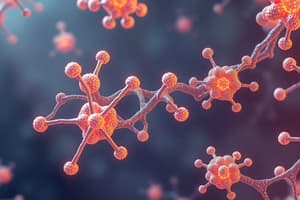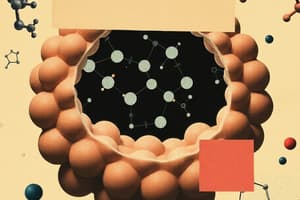Podcast
Questions and Answers
Which of the following best describes the primary difference between a nucleoside and a nucleotide?
Which of the following best describes the primary difference between a nucleoside and a nucleotide?
- A nucleoside contains a phosphate group, while a nucleotide does not.
- A nucleoside contains a deoxyribose sugar, while a nucleotide contains a ribose sugar.
- A nucleotide contains a phosphate group, while a nucleoside does not. (correct)
- A nucleotide contains a nitrogenous base, while a nucleoside contains a purine or pyrimidine.
In the context of enzyme catalysis, what is the role of the activation energy barrier?
In the context of enzyme catalysis, what is the role of the activation energy barrier?
- It indicates the final energy level of the products.
- It represents the minimum energy required for a reaction to be exothermic.
- It's the energy required for reactants to reach the transition state. (correct)
- It's the energy released when a substrate binds to an enzyme's active site.
Which statement best describes how quaternary structure of a protein is formed?
Which statement best describes how quaternary structure of a protein is formed?
- It consists of the linear sequence of amino acids held together by peptide bonds.
- It is stabilized by a combination of covalent and noncovalent interactions, including van der Waals.
- It involves the association of two or more polypeptide chains. (correct)
- The polypeptide chain folds and coils, stabilized by hydrogen bonds.
What structural feature do cellulose, starch, and glycogen have in common?
What structural feature do cellulose, starch, and glycogen have in common?
Which property do lipids exhibit due to their dual nature?
Which property do lipids exhibit due to their dual nature?
Flashcards
Macromolecule Synthesis
Macromolecule Synthesis
The process of forming new molecules by combining smaller units, called monomers. It occurs in a specific direction, adding monomers one at a time to a growing chain.
Nucleotides
Nucleotides
The fundamental building blocks of nucleic acids, composed of a sugar (ribose or deoxyribose), a phosphate group, and a nitrogenous base.
Primary Structure of a Protein
Primary Structure of a Protein
The structure of a protein, determined by the sequence of amino acids. It forms a chain-like structure that folds into specific shapes.
Enzyme
Enzyme
Signup and view all the flashcards
Amphipathic Lipids
Amphipathic Lipids
Signup and view all the flashcards
Study Notes
Preview of Cell Biology
- Historical perspectives in cell biology
- Techniques used in biological inquiry
- Strands of biological inquiry
Macromolecules I
- Carbon's importance in biological chemistry
- Types of chemical bonds and their strength of association
- Macromolecule synthesis (directionality, monomers, activated monomers)
- Nucleic acids (DNA vs RNA): composition, structure, monomer differences, nucleotide vs nucleoside, base pairing (Chargaff's rule), Griffith S-R strain experiments.
Macromolecules II
- Proteins (monomers, amino acid composition, directionality of synthesis, primary, secondary, tertiary, quaternary structures, and bonding differences)
- Enzymes: catalysts of life
- Activation energy barrier
- Catalyst properties
- Enzymes (proteins and RNA)
- Induced fit model
- Reversible and irreversible enzyme regulation (activation and inhibition)
Macromolecules III
- Polysaccharides (monomers, structures, L-D isomers, cell structural and storage roles, examples: Cellulose, Starch, glycogen, pectin)
- Lipids (types of lipids, function, amphipathic properties)
Studying That Suits You
Use AI to generate personalized quizzes and flashcards to suit your learning preferences.




